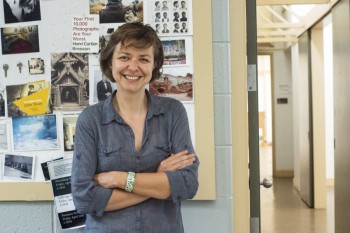A Photographic Education

Vita Litvak '02
Photo by Patrick Montero
Details
A career in the arts can often seem out of reach, so Vita Litvak '02 remembers clearly when she realized there was a place for her in the world of photography. She was taking a class with Audrey A. and John L. Dusseau Professor in Humanities and Professor of Fine Arts William Williams, and he arranged for Litvak and fellow future photographer Sarah Kaufman ‘03 to attend the annual Society for Photographic Education (SPE) Conference, which brings together artists, educators, and students around a different theme each year. The changing themes, however, are less important than the conference's perennially diverse, encouraging environment.“Before, just being [at] Haverford, and my reference point being so narrow,” Litvak says,“I really had no idea of the extent to which I could be involved.”
Litvak would go on to get her MFA in photography and film at Virginia Commonwealth University. She returned to Haverford in 2013 as a visiting assistant professor of photography, with the recommendation of Williams, a noted photographer himself who is also the curator of Haverford's substantial photography collection. Now, Litvak builds off the critical-theory curriculum Williams has fine-tuned since his arrival in 1978. Like Williams, she provides her students with plenty of opportunities to broaden their perspectives and realize their potential. Students in the color photography class she taught in the spring took field trips to the Philadelphia Museum of Art, to photographer Barbara Kasten's exhibition at the Institute of Contemporary Art, and to the Association of International Photography Art Dealers show in New York City. The class also completed a five-week analysis of photographer Zoe Strauss' Sea Change exhibit at campus' Cantor Fitzgerald Gallery, and some students were able meet with the artist for a discussion outside class.
“As a person who began with a very limited understanding of photography, I didn't at first appreciate the importance of the sequencing of photographs in Sea Change,” says Marty Gibson-Garcia '15, a fine arts major.“Through spending more time with the exhibit, as well as through conversations in class, I became more aware of the nuance involved in the selection of images included. … The show is meant to be read like a sestina, a poem that confuses our sense of time by introducing and reintroducing symbols, manufacturing a sense of déjà vu within the show.” Heidi Gay BMC '15 says Strauss was candid with students and discussed the nitty-gritty details of putting together a solo show.
And, over spring break, Litvak continued Williams' legacy and brought Gay and two other members of the class, Alina Van Ryzin '17 and BamBoo Ding '16, to the Society for Photographic Education conference, held this year in New Orleans. The conference's location and theme—Climate, Equity, and Community—directly related to Strauss' Sea Change exhibit, which examined the aftermath of three American ecological disasters: the BP Deepwater Horizon oil spill, Hurricane Sandy, and Hurricane Katrina. Like Strauss' images, the conference emphasized photography's power to reveal and obscure the truth about distant, complex subjects. But the conference also provided general insight into the process of making a photograph, assembling a body of work, and ultimately pursuing a career in the field of photography. Students viewed portfolios by photographers from around the world, received feedback on their own work, and heard talks by fine-art photography heavyweights Chris Jordan, Hank Willis Thomas, and Rebecca Solnit. The experience affected the three much as it did Litvak so many years ago.“It gave me a huge insight,” says Gay,“into what I am really passionate about and what I'd like to pursue after graduation.”
-Sam Fox ‘14



